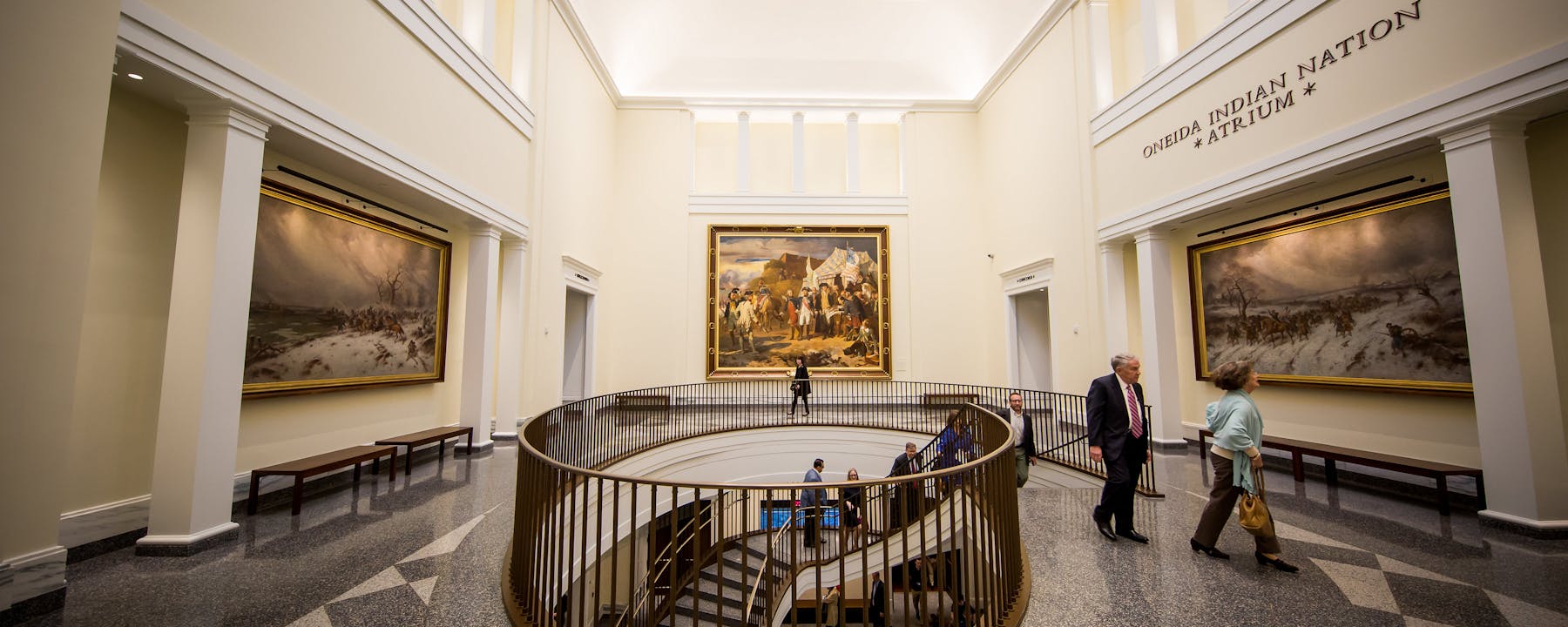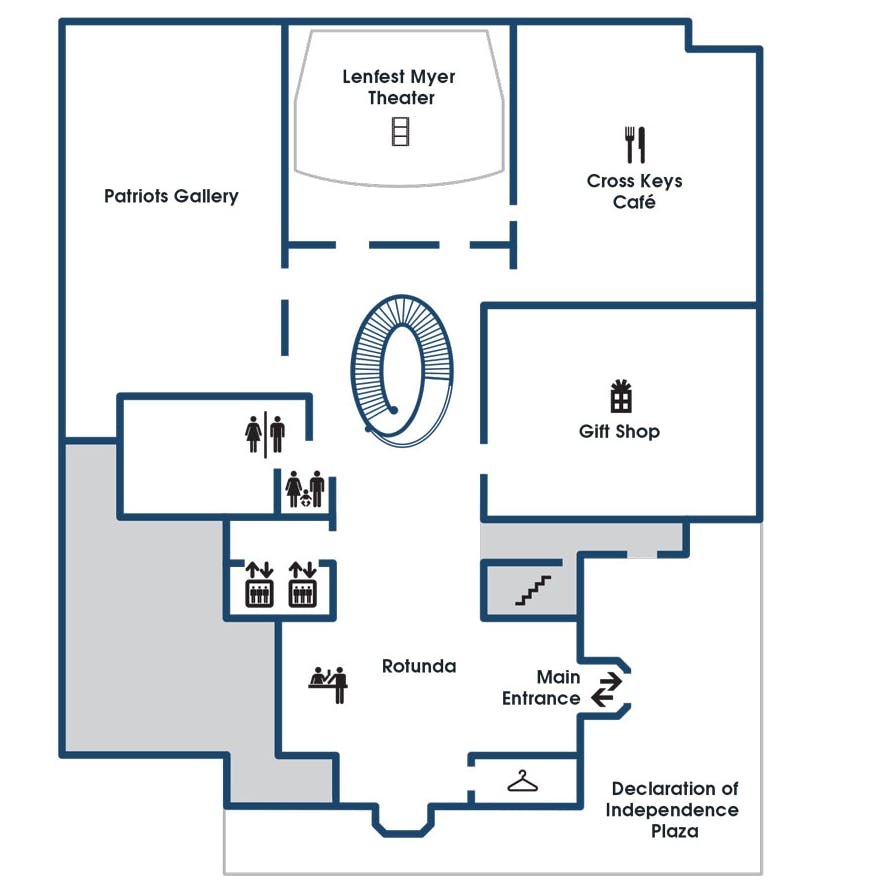
Museum Map
First Floor Map
Purchase tickets or become a member at the Front Desk located on the first floor of the Museum's Rotunda.
The Museum is committed to making its facilities, exhibits, and programs accessible for all audiences. Wheelchairs for use within the Museum are available free of charge on a first-come, first-serve basis at the Front Desk.
Located in the Museum of the American Revolution, Cross Keys Café welcomes both guests and locals to enjoy snacks and meals made with locally sourced produce, made-to-order barista menu, and seasonal outdoor seating. Beer and wine are also available. Salads, sandwiches, and wraps are available for purchase at the Café.
Cross Keys Café Hours
Daily, 10 a.m. - 4:30 p.m.
Discover unique gifts, books, and artifact reproductions in our shop at the Museum. The Museum Shop is open during Museum operating hours, and you can shop the Museum Shop online anytime.
Begin your visit in the Lenfest Myer Theater, located on the first floor, with our orientation film, Revolution. This sweeping film explores the origins, experiences, and ongoing legacy of the American Revolution–setting the stage for your exploration of our core exhibition. This 15-minute film is shown throughout the day.
Don't miss the People of the Standing Stone film, which explores the crucial but little known history of the extraordinary contributions of one Native American people who chose to commit themselves to the Patriot cause when nearly all other tribes fought on the side of the British during America’s War for Independence. This 25-minute film is shown once a day at 3:30 p.m.
Patriots Gallery features 5,000 square feet of flexible, multipurpose space to accommodate special exhibitions and large capacity events. When not in use showcasing short-term exhibits, the gallery is available for private event rental and can also be subdivided to host concurrent event programming.
Second Floor Map
Guests will not want to miss this moving immersive film that follows General George Washington's remarkable journey from commander in chief to first president and sit in the presence of his original Revolutionary War headquarters tent. The Washington's War Tent film is presented in Alan B. Miller Theater.
The Oneida Indian Nation Atrium on the second floor of the Museum features three impressive paintings depicting major events of the Revolutionary War.
A hand-painted copy of French artist Louis Charles-Auguste Couder’s Siege of Yorktown (1781) depicts Washington and Rochambeau giving orders at Yorktown, Virginia and is displayed at the top of the Museum's Grand staircase. Rochambeau played a major role in helping the Continental Army win the war. The two men stand in front of a marquee tent much like George Washington’s Headquarters Tent, one of the most iconic surviving artifacts of the Revolution, which also is featured in the Museum.
On the flanking walls are two late-19th-century paintings by Harrington Fitzgerald, a Philadelphia newspaper editor and writer who took up painting and is believed to have studied with Thomas Eakins. “The Foraging Party,” depicts Washington and his troops at Valley Forge, and the facing canvas portrays “Washington Crossing the Delaware.”
Becoming Revolutionaries (1760-1775)
The rumblings of the American Revolution began more than a decade before the “shot heard ‘round the world” ignited America’s War for Independence. Discover through seven galleries how the American Colonists–most of them content and even proud British subjects–became Revolutionaries as the roots of rebellion took hold. See how conflict over Native American lands and western settlement created the first rumblings of American discontent.
The Darkest Hour (1776-1778)
As the fragmented colonies entered an uncertain war, wrestle alongside the colonists with the ideals of liberty and independence versus the realities of fighting a war against the most powerful and professional military in Europe. Experience America during the darkest hours of the Revolutionary War.
A Revolutionary War (1778-1783)
Explore the final years of the War for Independence from the multiplicity of perspectives of the people who lived through it. Could enslaved people find liberty, either in the American or British Armies? Could Native Americans be part of the new American republic? Did Loyalists have any rights in the Revolutionary states? Explore how Revolutionary Americans struggled with these — and other — weighty questions, even as their prospects of victory brightened.
A New Nation (1783- present)
With the hard-fought establishment of the United States of America, the Revolutionaries succeeded in gaining independence. But then came the immense task of creating a nation founded on the principles of life, liberty, and the pursuit of happiness. As you conclude your journey, watch as the new nation — born of the War for Independence — begins its own.
John M. Templeton Jr. Education Center (Lower Level)

Take the elevators and press the button for "0" to access.
What was life like in Philadelphia during the Revolutionary War? The Museum’s discovery center, Revolution Place, brings to life the Museum’s lively, diverse Old City neighborhood during the 1700s and invites visitors to learn through hands-on exploration.
Revolution Place features four key recreated historical environments – a military encampment, a tavern, a home, and an 18th-century meeting house – to immerse and engage families, especially kids 5-12 years old, in the places where the American Revolution took root. Visitors will enjoy experiential elements, interactive touchscreens, reproduction objects, and special programming set against colorful murals that evoke scenes from 18th-century Philadelphia.
Revolution Place is included in regular Museum admission.
Regular Hours: Saturdays & Sundays from 11 a.m. - 4 p.m.
Summer Hours (Flag Day through Labor Day): Daily, 11 a.m. - 4 p.m.
Located on the Museum’s lower level in the John M. Templeton Jr. Education Center are two large multipurpose classrooms for students and other groups to use for lunches, further learning, seminars, workshops, and more.
Declaration of Independence Plaza

This dramatic display of five cannon from the Revolutionary era are on loan from the Girard Estate in Philadelphia.
Don't miss the powerful words from the Declaration of Independence emblazoned in limestone on one of the plaza's flanking walls.
Designed by artist Ellen Qiong Schicktanz, the Museum has two bronze sculptural reliefs installed along Chestnut Street.
The first sculpture is located in the William and Lauran Buck Revolution Courtyard and features Emanuel Leutze’s “Washington Crossing the Delaware.” The nighttime crossing of the Delaware River was the turning point of the Revolution, when Washington’s army, despite months of demoralizing defeat, found the courage to launch a nearly impossible raid that galvanized the entire nation.
The second sculpture is located in the Marjorie and Lewis Katz Liberty Courtyard and features John Trumbull’s “The Declaration of Independence.” The original painting is displayed in the U.S. Capitol in Washington. The foreground figures are life-size, drawing pedestrians into the iconic depiction of the presentation of the Declaration of Independence to the Continental Congress by the drafting committee, which included Benjamin Franklin, John Adams, and Thomas Jefferson.
Accessibility
The Museum of the American Revolution is committed to making its facilities, exhibits, and programs accessible for all audiences in compliance with the American with Disabilities Act (ADA). Learn more about the Museum's facilities and sensory information.

